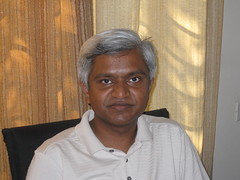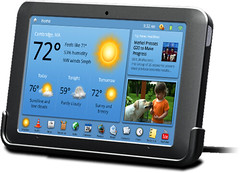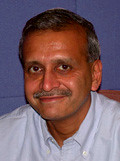(This article is a based on a broad and free-wheeling interview of Ajay Bhagwat, founder of Renu Electronics, by Navin Kabra and Amit Paranjape)
To a large extent, the computer technology in India is synonymous with software technology. So, when we found that Renu Electronics manufactures all its own hardware for all the products it sells, including LCD panels, and that this is all being done in a small building on Baner Road, we were shocked.
Renu Electronics, founded by Ajay Bhagwat, has generally maintained a low profile, but has a very interesting story to tell.
Early Years
Ajay has an interesting educational background. After his engineering at IIT-Bombay, he went to the US on an L&T scholarship, and did his Masters from the University of Iowa. Here, he excelled, finishing his Masters in 9 months, in the process getting some really interesting results. Specifically, he figured out an algorithm in control systems to determine whether a particular system’s transfer function could be identified adaptively or not. This result was useful enough that some senior professors from UIUC and industry folks from GM requested him to do some additional work on this algorithm to get some specific results they were interested in. For this additional work, which he did in a few months, he got an one more Masters degree from University of Illinois at Urbana-Champagne.
1990s – Starting Renu Electronics
Ajay came back to Pune in 88, and by 1992, had decided to start Renu Electronics, 100% export oriented unit selling HMIs (human machine interfaces; i.e. front end control panels for industrial control systems). The basic idea was to sell a common front end panel that could talk to many different backends and give the customer a common interface. The trick is to be able to talk all the different protocols of the different backend systems (which did not have standards or interoperability). This was done using a core firmware and then pluggable drivers for each backend – which also made it easy to add support for new backends. This was a big improvement in usability since having to teach floor technicians a different front end interface for each backend manufacturer was a major pain point for his customers.
At this time, the majority of the business came from white labeling this technology to established brands. Even GE approached them and started selling this technology under the GE brand. He was one of the few people in India at that time who was exporting technology to the US and Europe instead of importing it. When he was filling out a customs department form for this purpose, he got scolded by the customs officer for putting machinery in the outgoing column and money in the incoming column. The officer knew that things are supposed to be the other way around. It took a long time to convince him that the form was indeed correct.
Building Products
Renu’s flagship products are HMIs which allow industry floor operators to do configuration entry, monitoring of status, alarms in case of exceptional conditions, production of reports, and trends (graphs).
By 1995, Renu had decided that they would manufacture all their own hardware. By designing the entire system in-house they were able to achieve efficiencies that wouldn’t have been possible otherwise. For example, they used the 8051 chip, and made maximal use of all the features of this chip, so that they were able to do alarm handling, interfaces, dual-port communications, using just the internal RAM of the 8051 chip – which is just 256 bytes. This gave them a huge cost advantage. At one time, they got threatened by a competitor from Europe that dumping (i.e. selling a product at a price less than it costs to manufacture) is illegal and they would take action. The competitor was very surprised to learn that Renu was actually making a 20% profit in spite of the ridiculously low price.
Renu have always been a product company. They have never done a custom product for anyone, and they’ve always owned their own IP.
Initially, they were only providing the front ends, but soon they wondered whether they they should make their own PLC. All the top PLC companies were Renu’s customers, and Renu did not want to upset the customers. But it turns out that customers actually encouraged Renu to enter this space. They were not worried about competition from Renu, but were happy that Renu would understand the market and domain even better and come up with even more innovative products that they could white label.
Renu was the first company in the world to put the PLC in the HMI itself. This works well for smaller systems. But it also led to too many different products and was messy in terms of sales and marketing – and was confusing to customers. So they designed a modular system which allows PLCs to be chained together to create simple or complex PLCs depending upon what exactly the customer needs. This makes it easier for the customer to create a customized system that exactly meets their needs, without having to go for a high-end, expensive system. The fact that the HMI can be with the PLC, and there is no new system and software to be integrated and learnt is another advantage. Now, finally, they have started a line of modular PLCs without the HMI, and most growth in recent years is coming from
the modular PLCs (with or without HMIs).
Focus on Quality
One of the biggest problems faced by Ajay was that neither he (nor most other people in India) understood how to create an industrially robust process. This resulted in manufacture of components that had latent problems – i.e. units that work perfectly fine, but stop working 6 months later. After they continued to have latent failures they learnt from their customers the various things they need to do to ensure long-term quality of their devices. They spent lots of time and money getting in-house quality control equipment and processes. This high level of quality control results in very reliable products – and this is now one of the USPs of Renu Electronics.
We took a tour of the premises and saw some of the advanced equipment used for testing at Renu. There’s one unit that allows devices to be tested at temperatures from -40 to +60 degrees Celsius. Another unit allows humidity testing up to 98% humidity. A voltage fluctuation/spike/pulse tester can produce a spike of 2Kv in 1 nanosecond. This is in addition to vibration testers, RF interference testers, and 60+ other tests. They have installed anti-static flooring on their manufacturing area. This is very expensive at Rs. 1600 per square foot, but has paid off handsomely, because their latent errors are now down to almost zero.
Staying Ahead of The Curve
Renu believes in implementing processes that they believe are the right thing to do in the long term irrespective of whether they are immediately required by customers or the law. For example, Renu is one of the few ISO-14001 compliant companies. Sometimes, this causes a problem for other companies, because Renu sets the standard and soon the others are expected to follow. On the other hand, sometimes this causes a problem for Renu.
For example, Renu was one of the first companies companies that was ROHS compliant. For this, they had to invest in ROHS compliant machinery and components – which cost significantly more. Further, their running costs went up, because the components they needed on a regular basis were more expensive. But, they’re still ROHS compliant because it is the right thing to do. This story has a happy ending (financially) though – from 1st January, 2012, this investment is going to pay off because there are two new Indian Government directives that will enforce control of hazardous materials, and Renu will already be compliant, whereas other companies would have to struggle.
KPIT Story
Ajay Bhagwat was also one of the promoters of KPIT, one of Pune’s most well known software services companies.
When Ajay was in IIT, he was very interested in music, and would organize and compete in music competitions (he was one of the people behind the creation of a program called Sur-Bahar, which still happens). Shirish Patwardhan was one of the people Ajay used to bump into at music competitions at IIT. Later, in the late 80s they met again in Pune, and started talking about starting a company for doing software products/services. So Ajay joined the software wing of Kirtane and Pandit (an accounting firm) and KPIT was born. Ajay helped set up the quality systems, and the embedded team for KPIT. Although Ajay has been out of day-to-day functioning of KPIT for a long time, he was a director of KPIT until recently.
Contributions to the tech/startup ecosystem in Pune
To those watching the startup ecosystem in Pune, it is clear that Ajay is also one of people helping TiE Pune’s revival this year. This year, TiE has had fortnightly ‘My Story’ sessions with very interesting and accomplished entrepreneurs, and monthly ‘Breakfast sessions’ with more free-wheeling discussions on issues of interest to entrepreneurs. This vitality of TiE in Pune is a very welcome addition to the startup ecosystem in Pune, and will certainly go a long way in cementing Pune’s position as one of the top destinations for doing startups in India.
As a charter member of TiE Pune, Ajay also sets aside 5 to 6 hours every week for one-on-one mentoring of entrepreneurs in Pune. This is a non-trivial time-commitment for any busy executive, but even that, says Ajay, is not enough. There is need for more mentorship of entrepreneurs in Pune. If you have a startup in Pune with actual revenues and enterprise sales, we would suggest talking to Ajay
for some guidance.



![Reblog this post [with Zemanta]](http://img.zemanta.com/reblog_b.png?x-id=a94ed4f5-a95b-4b6a-b4fb-d6261e766fe4)

![Reblog this post [with Zemanta]](http://img.zemanta.com/reblog_b.png?x-id=76f9a3ed-25c4-40ad-98a4-d3be727fb0b5)
